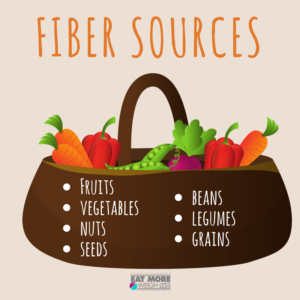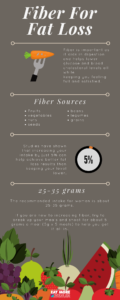Although more women are paying attention to their macronutrients, fiber is a micronutrient that most people tend to ignore. Fiber is important as it aids in digestion and helps lower glucose and blood cholesterol levels all while keeping you feeling full and satisfied. Power Eating author Susan Kleiner, even goes so far as to say that increasing fiber intake by just 5% would help most people improve fat loss results.
Fiber is not available via fat or protein, which means that eating carbohydrates is key to getting in enough fiber. So if you’re carbophobic, but always coming up short on this micro, it may mean that you have to get off that low carb train in order to do it!
Great Fiber Sources
Fiber is best in its “natural” form. Supplements like Metamucil and the like can certainly come in handy, but it’s best to get your intake in from eating real foods. Some of the best options are:
- Fruits
- Vegetables
- Nuts
- Seeds
- Beans
- Legumes
- Grains
Eating carbs may be scary for some, but have no fear. Focusing on higher fiber choices will help guide you in eating the right kind of carbs for your goals, round out your diet, and compliment your other macros.
 While the recommended intake is about 25-35 grams, most women are lucky to get in about 15 grams in a day. This is one element of your diet that you want to increase very slowly (and with lots of water!) to allow your body time to adjust.
While the recommended intake is about 25-35 grams, most women are lucky to get in about 15 grams in a day. This is one element of your diet that you want to increase very slowly (and with lots of water!) to allow your body time to adjust.
Water is essential to increasing your fiber! By not drinking enough, your digestive system will essentially create concrete making it very hard to pass through your bowels. Give your stomach a chance to adjust and increase very slowly.
When increasing your fiber, remember that some choices may work better for you than others, or rather that some will give you more bang for your buck. An apple or orange have about 3 grams, but a cup of raspberries has about 9 grams! So look at your fiber options and how you can get the most out of your choices. Celiacs (or anyone for that matter!!) can opt for grain options like millet or brown rice rather that oats and barley, the key is to adopt the habit AND make it work for you.
If you are new to increasing fiber, try to break up your meals and aim for about 5 grams per meal (5g x 5 meals = 25g/day). If you’re eating fewer meals, then you’ll want to work up to more fiber (ex. 7-8g) per meal to help you get it all in. Again, take your intake for these goals up slowly and increase your water accordingly!
Are you curious about how the process works, or wondering what's in our Starter Kit E-Book? START HERE. We'll send you a free breakdown of the basics, exclusive videos explaining why everything that you've learned about diets have only led you astray, and an action plan to take your life back immediately.
No worries, we hate spam too!






Recent Comments